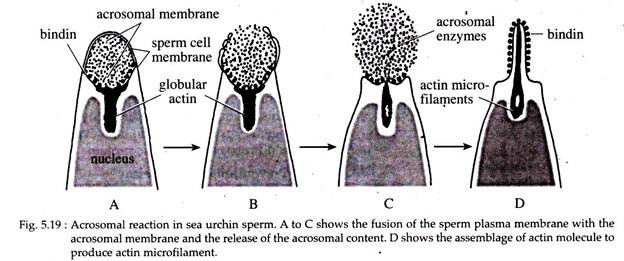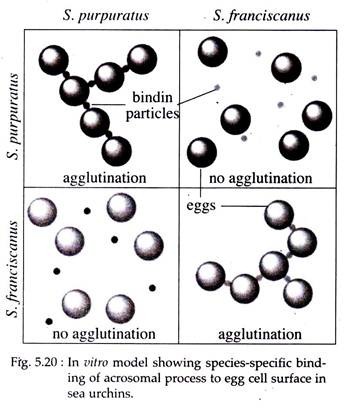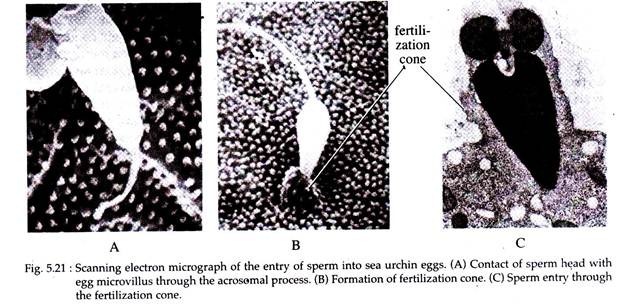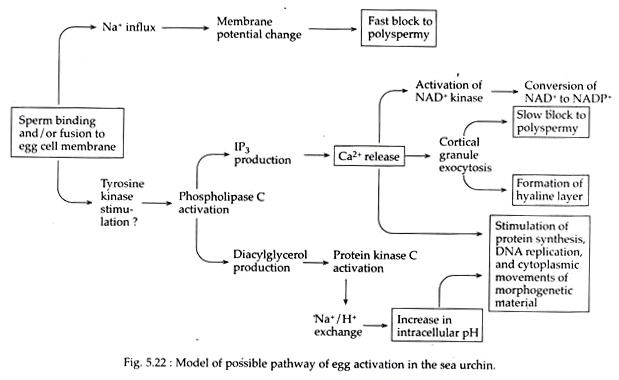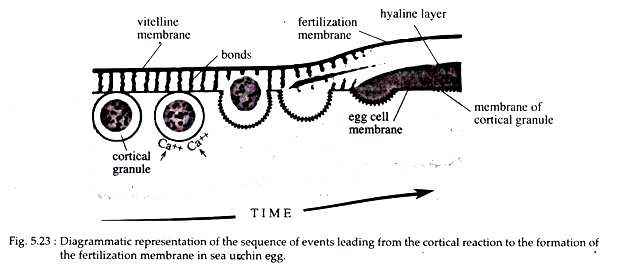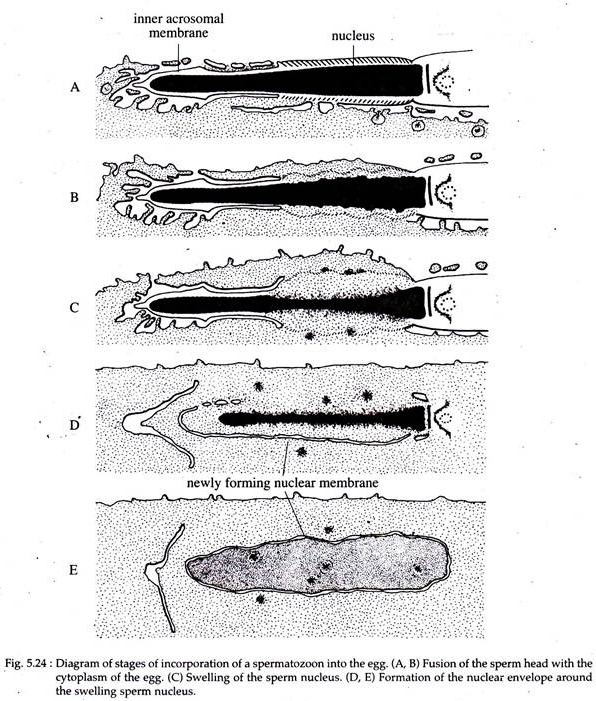The following points highlight the top seven events of fertilization in sea-urchin. The events are: 1. Contact and Recognition between Sperm and Egg 2. Acrosomal Reaction and Sperm Penetration 3. Binding of Sperm to the Egg 4. Prevention of Polyspermy 5. Metabolic Activation of the Egg 6. Formation of Pronuclei 7. Migration of Pronuclei and Fusion of the Genetic Material.
Events of Fertilization in Sea-Urchin:
- Contact and Recognition between Sperm and Egg
- Acrosomal Reaction and Sperm Penetration
- Binding of Sperm to the Egg
- Prevention of Polyspermy
- Metabolic Activation of the Egg
- Formation of Pronuclei
- Migration of Pronuclei and Fusion of the Genetic Material
Fertilization in Sea-Urchin: Event # 1.
Contact and Recognition between Sperm and Egg:
ADVERTISEMENTS:
The mode of fertilization in sea urchin being external, the egg and spermatozoa are released into the sea water. The first step is the encounter of spermatozoa and the egg. This encounter is brought about by the swimming movement of the spermatozoa. To ensure the survival of the species, the gametes are produced in large numbers.
A single female Arbacia releases about 4 million eggs, while the male releases about 100 billion spermatozoa, during a single spawning. Not-withstanding this, adult sea urchins improve the chances of a sperm meeting an egg by moving into dense aggregates before spawning.
However, a successful fertilization depends largely on coordinated timing in the release of gametes and water conditions at that time.
Species-specific sperm attractants have been found in sea urchin. Sperms are attracted towards eggs of their own species by chemo-taxis, i.e., by following a gradient of a chemical, secreted by the egg. One such chemotaxin is a 14-amino acid peptide called resect, has been isolated from the egg jelly of a sea urchin Arbacia punctulata. Resact diffuses readily in sea-water.
ADVERTISEMENTS:
A very low concentration of resact in the sea water can attract sperm of its own species. The sperms of A. punctulata have receptors in their plasma membranes that bind resact. Resact also acts as a sperm-activating peptide that causes drastic and immediate increase in mitochondrial respiration and sperm motility.
Fertilization in Sea-Urchin: Event # 2.
Acrosomal Reaction and Sperm Penetration:
The acrosomal reaction has two parts:
ADVERTISEMENTS:
(i) The fusion of the acrosomal vesicles with the sperm plasma membrane and
(ii) The extension of the acrosomal process.
The acrosomal reaction in sea urchin is initiated by contact of the sperm with the egg jelly, that causes exocytosis of the sperm’s acrosomal vesicle and the proteolytic enzyme present in the acrosome gets released. This enzyme digests a path through the jelly coat till it reaches the egg surface.
The acrosomal reaction is stimulated by an exchange of extracellular Ca++ with intracellular K+ by sperm plasma membrane resulting in the increase of intracellular pH to more than 7-2. This initiates the localized fusion of the outer acrosomal membrane with the plasma membrane (Fig. 5.19). This releases the soluble enzymes located within the acrosomal vesicle.
The second part of the acrosomal reaction involves the extension of the acrosomal process (Fig. 5.19). This involves the polymerization of the globular actin (g-actin) within the sub acrosomal region, to filament actin (f-actin).
The f-actin forms the basis of the acrosomal process, which protrudes from the head of the sperm. The tip of this acrosomal process is covered with a protein called bindin, that helps the sperm to bind to the egg surface.
A major species-specific recognition step occurs when the acrosomal process of the sperm, after having penetrated the egg jelly, comes in contact with the egg surface. The bindin that covers the acrosomal process is capable of binding (agglutinizing) to de-jellied eggs of the same species (Fig. 5.20).
The vitelline envelope or plasma membrane of the egg have species-specific binding receptors, that recognise the bindin of its own species.
After having passed through the egg jelly coat, the spermatozoa encounter the vitelline envelope, which is a tough non-cellular layer present between the jelly coat and the plasma membrane. The vitelline envelope is made up of glycoprotein and polysaccharide molecules. The spermatozoa digest their way through it with the help of acrosomal enzymes with trypsin like activity, commonly called lysin.
Fertilization in Sea-Urchin: Event # 3.
Binding of Sperm to the Egg:
The lysis of the vitelline envelope is followed by the fusion of the sperm plasma membrane with the plasma membrane of the egg. This membrane fusion is a common feature of fertilization in all animals. The binding of sperm with egg membrane appears to cause the formation of several microvilli in the egg plasma membrane.
The microvilli seem to engulf the head of the sperm, causing a bulge known as the fertilization cone in the egg (Fig. 5.21). The fertilization cone, like that of the acrosomal process, appears to be extended by the polymerization of actin.
The plasma membrane of the sperm is antigenically different from that of the egg. However, it becomes incorporated into the plasma membrane of the egg as a mosaic patch (Shapiro et al., 1980), as the sperm nucleus moves into the interior of the egg.
In the sea urchin all region of the egg plasma membrane are capable of fusing with sperm and this fusion is often mediated by specific “fusogenic” proteins. Bindin, however, plays a second role as a fusogenic protein.
Fertilization in Sea-Urchin: Event # 4.
Prevention of Polyspermy:
Normally in sea urchin monospermy results, in which only one sperm enters the egg. The entrance of multiple sperm, i.e., polyspermy, results in the establishment of polyploidy. This leads to disastrous consequences resulting in the early disruption of development and the death of the embryo.
Species, therefore, have evolved ways to prevent the union of more than two haploid nuclei and the most common way is to prevent the entry of more than one sperm into the egg. Sea urchin has evolved two blocks to avoid polyspermy.
The fast block to polyspermy is accomplished by a temporary electrical change in the egg plasma membrane. This is followed by a slower, more complex but permanent block called the slow block to polyspermy (Fig. 5.22).
The fast block is an adaptation for quickly cutting off access to the egg by sperms that are close behind the first one, in penetrating the vitelline membrane. It also buys off some time for the egg to set up the permanent block.
Fast Block to Polyspermy:
The fast block (Fig. 5.22) takes place within 2 to 3 seconds and lasts for about 60 seconds. It is achieved by altering the electric potential of the egg’s plasma membrane, called resting membrane potential. It is generally about 70mV which is usually expressed as -70mV as the inside of the cell is negatively charged with respect to the exterior.
The surrounding sea water has high sodium ion (Na+) concentration in comparison to the egg cytoplasm. The reverse is true for potassium ion (K+). Due to small influx of Na+ into the egg, the membrane potential shifts to a positive level (about +20mV), within 1-3 seconds after the binding of the first sperm. This formation of positive resting potential prevents further sperms from fusing to the egg.
Slow Block to Polyspermy:
The fast block to polyspermy initiates the slow block to ensure that multiple sperm do not enter into the egg cytoplasm. The first step in this is the mobilization of Ca++ from the stores present within the egg. Ca++ is first released at the site of sperm entry (Berger, 1992) and a wave of free Ca++ passes through the egg. This wave of released Ca++ initiates the cortical reaction.
The sea urchin egg contains about 15,000 cortical granules lying in a layer just beneath the plasma membrane. Each granule have a diameter of about 1 µm. The free calcium ions initiate the cortical granules to move to the inner surface of the plasma membrane and to fuse with it.
This ruptures the cortical granules, which then release their contents into the space between the plasma membrane and vitelline envelope, and a regular sequence of event follows (Fig. 5.23). Several proteins are released by the exocytosis of the cortical granules.
The first are proteases, a proteolytic enzyme that breaks the molecular bonds that bind the vitelline envelope to the plasma membrane. They also clip off the bindin receptor and any sperm attached to it.
Mucopolysaccharides (a second protein) released by the cortical granules produce an osmotic gradient, that causes water to rush into the space between peri-vitelline envelope and egg membrane. This causes the vitelline envelope to expand and thus form the fertilization envelope.
A third protein, peroxidase enzyme, released by the cortical granules, hardens the fertilization envelope. Finally, a fourth protein, hyaline, forms a coating around the egg below the fertilization membrane (Fig. 5.23). This hyaline layer provides support for the blastomeres at the time of cleavage.
Fertilization in Sea-Urchin: Event # 5.
Metabolic Activation of the Egg:
The sea urchins mature egg is a metabolically sluggish cell that is activated by the sperm. This activation is merely a stimulus for undergoing metabolic events that were pre-programmed (at the growth phase of oogenesis).
The activation of the egg starts with the two blocks to polyspermy – the fast block initiated by sodium ion influx into the cell and the slow block by the intracellular release of calcium ions. The release of Ca++ appears to be the main stimulus for the activation of egg.
Such an increase of Ca++ occurs either through its entry into the egg from outside, or by its release from the endoplasmic reticulum within the egg. The first mechanism occurs in snails and worms, while in fishes, frogs, sea urchins and mammals, most of the Ca++ probably comes from the endoplasmic reticulum.
Other than the cortical reaction, the events that take place (Fig. 5.22) include:
(a) A three to five fold increase in oxygen consumption, (probably related to the formation of H2O2).
(b) Activation of the enzyme NAD+ kinase which converts NAD+ to NADP+ (Epel et al. 1981). This conversion may facilitate the biosynthesis of new membrane lipids, which is important in the construction of many new cell membranes required during cleavage.
(c) A second influx of Na+ coupled with an efflux of H+ from the cell, resulting in the increase of intracellular pH. This increase of pH leads to an increase in protein synthesis, the activation of transport systems and ultimately the initiation of DNA synthesis, in preparation for the first cleavage division.
Fertilization in Sea-Urchin: Event # 6.
Formation of Pronuclei:
In sea urchin, the nucleus of the sperm enters perpendicular to the egg surface. On fusion of the egg and sperm plasma membrane, the sperm nucleus and centriole separate from the mitochondria and flagellum. Latter the two disintegrate inside the egg cytoplasm.
Shortly after the entry of the sperm into the egg cytoplasm (lifting the block to the second meiotic division and releasing the second polar body), the nuclear membrane of the sperm breaks down (Fig. 5.24). The interaction between the nuclear contents of the sperm and the cytoplasm of the egg results in de-condensation of the tightly packed nuclear chromatin.
As the chromatin dispersion nears completion, a new nuclear membrane is formed. The nucleus thus becomes vesicular and has an appearance like the interphase nucleus and is called the male pro-nucleus. The nucleus of the egg also undergoes certain changes. After completion of the second meiotic division, the haploid nucleus of the egg forms the female pro-nucleus.
Fertilization in Sea-Urchin: Event # 7.
Migration of Pronuclei and Fusion of the Genetic Material:
When the sperm was entering the egg, the nucleus was in front followed by the centriole. As the sperm moves inward, from the site of the fertilization cone, it soon rotates 180° so that the centriole assumes the leading position and is positioned between the sperm and egg pro-nucleuses. It provides the basis for the formation of the sperm aster that plays a major role in guiding the migrations of the pronuclei.
The radiating array of microtubules of the sperm aster pushes against the inner surface of the plasma membrane of the egg and helps to displace the male pro-nucleus towards the centre of the egg. As the rays of the sperm aster reaches the female pro-nucleus, it rapidly moves along the rays toward the male pro-nucleus.
Both the pronuclei are then pushed to the center of the egg by the expansion of the sperm aster. In sea urchins, the two pronuclei come into contact with each other, their membranes fuse, resulting in the formation of a single membrane, which encloses both male and female chromosomes.
This process is called pronuclear fusion, resulting in the formation of the diploid zygote nucleus. Soon after the pronuclear fusion, the chromosomes replicate their DNA, for the first cleavage division. As the chromosomes prepare for the first cleavage division, the process of fertilization is completed.
In case of the mammals as the two pronuclei migrate’ towards each other, it replicates its DNA. The two nuclear envelopes,, on mating, break down and the chromatin condenses into chromosomes that orient themselves on a common mitotic spindle. The nuclear membrane is formed only at the 2-cell stage.
